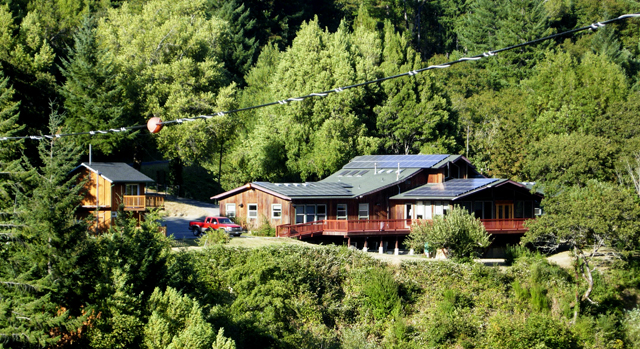
Since 1999, Schatz Lab has worked with the Yurok Tribe on several grants, studies and energy projects to improve sustainability. Past projects have included a fuel-cell system to provide back up power to a radio repeater station, a feasibility study for hydroelectric and wind energy development and energy audits of over fifty tribal households and multiple government buildings.
Most recently, local solar experts, Roger and his Merry Band of Solar Installers, outfitted the Tribe with a solar electric system. The Tribe also performed energy efficiency upgrades in its Weitchpec tribal office and is working to install energy efficiency upgrades at its Klamath office.
“Stewardship is a huge element of tribal culture,” says Sophia Lay, a tribal planner and the project manager for this undertaking. “The key elements here were to be more sustainable and to lower our energy use.”
Funding for the projects came from the Department of Energy as part of the American Recovery and Reinvestment Act. Originally, that funding was to be used to conduct a retro-commissioning study for the Klamath office, install a solar panel system and enact certain retrofit projects. Retro-commissioning studies are used to identify existing structures and systems that could be altered to improve energy use. However, from 2005 to 2007, the Tribe and Schatz Lab had already performed an energy-needs assessment to identify such opportunities.
“Rather than spend money on a report to identify issues, we decided to do some of the retrofits we already knew about,” Lay says. Schatz Lab worked with the Tribe to adjust the project proposal and the Department of Energy agreed to award the grant without requiring a retro-commissioning study.
Instead, that funding went to other projects. The tribal building in Weitchpec received energy efficiency upgrades to its heating and cooling systems and occupancy sensors for its lighting system. “Small changes like this are really beneficial,” Schatz Lab engineer Richard Engel says. “They’re relatively simple. They make sure no equipment is running unnecessarily. And they save energy.”
Additionally, the building received a 15.7-kilowatt solar electric array. That system was increased from a 13.6-kilowatt system after the price of photovoltaic equipment went down.
Schatz Lab engineers also developed an interactive interpretive display for the lobby of the Weitchpec tribal building. The full-color, touch-screen display allows users to get information on the energy efficiency upgrades of the project, including the real-time energy production of the new solar array. Information from the interpretive display will also be accessible online.
“The display definitely catches your attention as soon as you walk in the door,” Lay says. “If the information doesn’t get people’s attention right away, the fact that it’s interactive will.”
Work at the tribal building in Klamath is currently underway. Those energy efficiency upgrades include weatherizing seals on doors and installation of ceiling fans to improve heating and cooling and prevent stratification. In a room with high ceilings like the Klamath building, stratification occurs when warm air rises and doesn’t circulate with the colder air near the ground. On a cold day, that means the heat has to be turned up much higher to heat the air near the ground. Ceiling fans will also help to circulate air and keep people comfortable on a hot day, without resorting to energy-sapping air conditioning.
As this project winds down, Schatz Lab and the Yurok Tribe have already submitted another grant proposal, this one to the Department of Housing and Urban Development, to continue to explore and implement actions to create a more sustainable community.
“Personally,” Lay says, “I learned a lot from this project, and that will carry over into my other projects in terms of energy efficiency.”